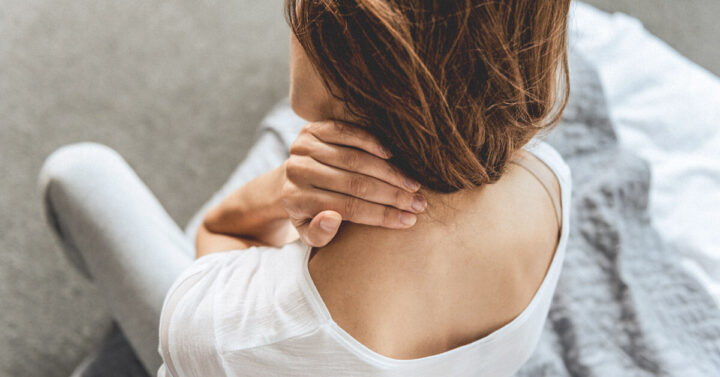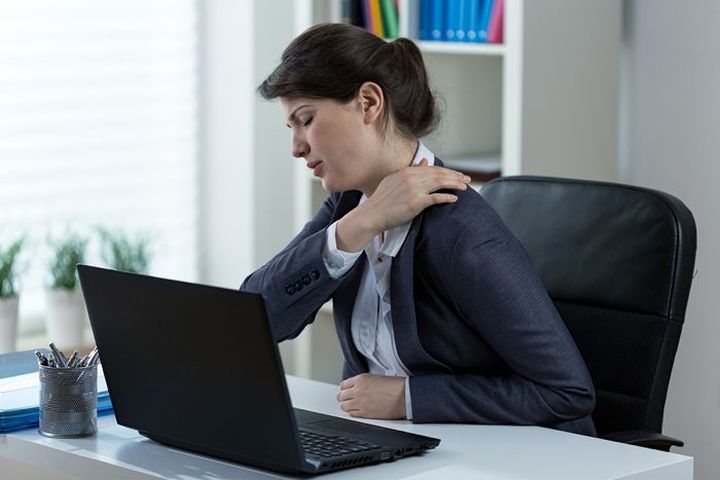Solving Lockdown Neck & Shoulder Pain

Working from home is the new normal. If you worked behind a desk before lockdown hit,
chances are you’re now spending at least some days per week working from the comfort of your
own home. This brings with it some great benefits: no commuting, a longer nights sleep, and the
freedom to tailor your working environment to however you see fit. But for every action, there’s
an equal and opposite reaction, and the consequences of this change are far-reaching. The lack
of need for a commute means we don’t need to get out of the house and get moving to travel to
work, meaning keeping active rests solely on your shoulders. Besides this potential reduced
physical activity, our homes aren’t necessarily kitted out to appropriately foster a positive
working environment. The sofa, the dining table, even the bed, these make-shift work areas are
not always conducive to healthy posture. The knock-on effect is felt in our bodies, with our
necks straining and our backs more hunched than ever. This causes tension, aches and strains
that can significantly reduce your quality of life.
This article, written by Pharmica the trusted online pharmacy, outlines the causes of pain in the
neck and shoulders, detailing some methods for preventing and reducing the issues.
The Causes

The exact causes of the pain you’re feeling in your neck and shoulders may not always be
immediately clear. Aches might be a result of long-term postural imperfections, whilst a sports
injury or accident might be still having a lingering impact.
Aspects that commonly cause neck and shoulder pain include:
● Incorrect Posture and/or Sleeping Position
● Injuries to your soft tissue, often in the form of a strain, from sport or whiplash, or any other
incident.
● Cervical osteoarthritis – this occurs when the neck’s spinal disks have been worn down,
usually occurring with age.
● Pinched Nerve – a compressed nerve going from the spinal cord to the neck can cause pain
that spreads throughout the shoulders.
Methods of Prevention and Treatment
Here are selection of methods that might reduce the pain in the problem areas.
1. Sleep

Sleeping is the one single act we as humans perform that take’s up the highest percentage of
our time, therefore it’s important not to ignore this aspect of life. Try these postural adjustments
to improve your quality of sleep.
Position
Sleeping on your front may not be such as gret idea, as this pushes your head over to the side
keeping your neck in a sideways bend, often leading to neck strain. Sleeping on your side is
better, although can result in stiff shoulders. Your best bet is to sleep on your back (unless you
snore heavily or suffer from sleep apnea).
Pillows
Having too many or too few pillows will disrupt the natural resting position of the neck, putting
your spinal cord out of symmetrical alignment. You may have to try different pillows with varying
degrees of hardness before finding one that causes the fewest neck problems when you wake
up in the morning.
2. Sitting

Unless your work is out and about, you most likely spend a lot of time during the day seated.
But how does this affect your pain?
Chairs
It’s well worth buying a supportive office-style chair, because the hard unergonomic dining chair
you’ve been using just won’t cut it. These chairs are designed to naturally flow with the body
and support the areas which need it the most. As well as this, they’re often highly adjustable to
suit different anatomies.
Screens
Screens and monitors should be positioned at eye level, as this is the ideal height to not cause
unnatural neck strain. You may need to lift or lower your chaor height to achieve this.
Standing
Have you ever seen videos one of those edgy hipsters from fun tech companies using those
motorised desks that raise and lower so you can either sit or stand whilst working? They’re fairly
expensive, but they’re a worth while investment for sprucing up your day with some variety of
posture. You can make your own DIY standing desk by standing a smaller table or chair on your
main table/desk.
3. OTC pain relief
Over the counter medication to relieve pain is the quickest reactive measure to quashing the
neck and shoulder pain. Ibuprofen and paracetamol are easy to get hold of medications that can
be taken by almost everyone (in moderation), and are cheap to buy. Whilst tablet or capsule is
the conventional vehicle for delivering the active medication, alternative such as topical gels
might be better suited to providing immediate relief to localised areas.
4. Specific exercises
General exercise is great, but it’s not always possible to do a full body stretch, a yoga class and
go for a jog whilst your boss is breathing down your neck. Targeting the problem areas with
specific exercises will make the best use of your precious time, and many of these don’t even
require leaving your desk.
Neck Rotating

Bring your head back whilst still looking ahead. Turn your head to the side as deeply as you
can. Hold this for a fwe seconds, return to neutral, and repeat, then alternate side. For a bonus
deep stretch, try looking over the back of your shoulder whilst in the stretch phase.
Shoulder Blade Pull
This exercise imitates a seated cable row, but without the resistance. Holding your arms in front
of yourself, imitate holding bicycle handle bars. Without straining your neck or shoulders,
squeeze your shoulder blades together, as if you were trying to get them to touch one another.
Go back to the resting position, and repeat however many times you see fit.
Shoulder Rolls
Hanging your arms down to the side, move your shoulders in a repetitive circular motion.
5. Heat Pad
One tried and tested method to alleviate muscle pain is by using heat to get the blood pumping,
speeding up the healing process. Made possible by using a heat pad, here’s how to make your
very own make-shift piece of equipment:
● Dampen 2 hand towels.
● Put 1 in an airtight bag, and microwave for 2 minutes with the bag open.
● Seal up the bag, and cover with the second wet towel.
● Push the heat pad on the affected areas to relieve the pain

